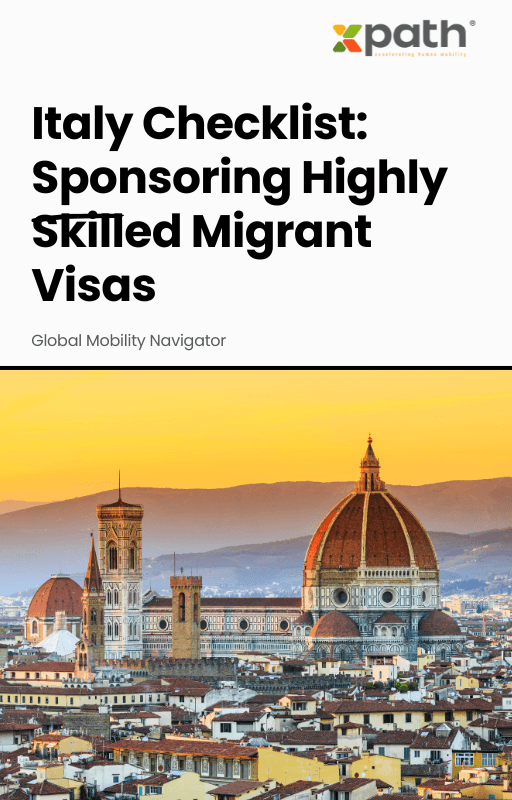Italy Checklist: Sponsoring Highly Skilled Migrant Visas
Grab a copy of a guide to international employee relocation
View E-bookThink about international assignments a decade ago. Paper trails, clunky spreadsheets, endless emails, and hours lost to coordination. Now, the pace of business rarely slows for administrative hurdles. According to a 2023 Deloitte survey, 74% of global mobility leaders called technology transformation a “critical” priority for improving their programs. Companies crave faster, more accurate processes for compliance, cost management, and employee experience. Embracing digital platforms turns chaos into clarity, creating a smarter, more agile global mobility function.
Global mobility has morphed far beyond moving boxes from A to B. Gone are the days when managing assignments meant only booking flights and organizing visas. HR now juggles tax compliance, cultural adaptation, remote-first policies, and ever-evolving immigration rules. Meanwhile, employees expect services as immediate, intuitive, and streamlined as their favorite apps. According to PwC’s 2022 Mobility Survey, 59% of assignees said the support they receive during a move directly impacts their engagement with their employer. The need for digital support has never been clearer.
What changes when you go digital? For starters, automation slashes manual effort and the risk of human error. Centralized data becomes a goldmine—critical for benchmarking costs, tracking compliance, and delivering personalized relocation support. Platforms like xpath.global enable holistic oversight, integrating everything from assignment management to vendor communication.
Consider this: in a 2024 cartus survey, companies using integrated mobility technology cut average case-processing time by over 40%. Plus, detailed analytics help organizations spot trends in policy utilization, predict future talent needs, and keep relocation budgets on a tight leash. Automated alerts also help avoid costly compliance slip-ups—vital as governments crack down on visa and tax errors.
Let’s make it personal. Global consultancy firm Arcadia Group faced dizzying delays using legacy processes—sometimes taking months to get new hires on site. After digitizing with xpath.global’s solution, assignment initiation-to-arrival time shrank by nearly half. Not only did Arcadia save on costs; they reported a 30% boost in relocation satisfaction scores, linking it straight back to transparent tracking and mobile-friendly communication. This story repeats across industries: companies embracing mobility digitization consistently report smoother transitions, happier talent, and fewer compliance fires to put out.
Let’s be real—transformation isn’t painless. The biggest challenge? Change management. According to Mercer’s 2023 Mobility Trends Survey, 62% of companies flagged user adoption as their top fear. Employees and managers may resist new systems until they see tangible benefits. Legacy data migration can be time-consuming, and it takes patience to tailor digital tools to unique mobility policies. Cybersecurity is also a concern, as sensitive personal data gets stored and shared via new channels.
The antidote? Clear communication, robust training, and choosing tech partners with rigorous data protection credentials—xpath.global, for example, is GDPR compliant and focuses heavily on privacy safeguards.
Bringing tech into global mobility isn’t just about efficiency—it’s about experience. Digital tools free up HR teams to focus on strategic tasks like talent development, while allowing employees to self-serve and track their moves in real time. The end result: empowerment, less stress, and higher global assignment success rates. Gartner notes that organizations leveraging strong digital mobility solutions have 23% higher assignment completion rates and reduced employee dropouts during relocation.
The big takeaway? Digitization isn’t about replacing humans; it’s about augmenting your function to match the demands of modern work and talent. Whether you’re a sprawling multinational or a fast-growth startup, investing in a robust global mobility solution like xpath.global positions you to attract, move, and retain world-class talent—without getting lost in the admin morass. So, are you ready to unlock smoother, data-driven, and more human-centric mobility?
What is a digital global mobility solution?
A digital global mobility solution is a platform or suite of tools that automates and streamlines the processes involved in relocating and managing international employees—from assignment initiation to repatriation.
How long does implementation take?
It varies, but most organizations see preliminary rollout in 2-4 months, depending on complexity and data migration needs.
Will digitization replace my HR or mobility team?
Absolutely not! The goal is to empower your team to focus on higher-value, human-centric activities—not replace them.
Is my data safe on platforms like xpath.global?
Yes, leading providers employ stringent security protocols and are compliant with privacy laws like GDPR.
What if our policies are complex or unique?
Flexible digital platforms are designed for robust customizations to fit your specific mobility framework.
Ready to transform your mobility program? Explore xpath.global’s solutions.

Italy Checklist: Sponsoring Highly Skilled Migrant Visas
Grab a copy of a guide to international employee relocation
View E-book